- Home
- Photoshop ecosystem
- Discussions
- Is there any way to make action that take the brig...
- Is there any way to make action that take the brig...
Is there any way to make action that take the bright part of the image into a mask?
Copy link to clipboard
Copied
Hi.
I'm facing the situation like this :
1. Make the mask from the area above a certain brightness level, from the grayscaled background image.
2. Adjust Hue/Saturation with mask.
3. I have to do Step 1, 2 again with more than 10 different BG images.
Of course, I can do it one by one, But It's actually timeconsuming.
So I tried to make a algorithm/actions. The problem is that I'm not sure If there is any way to aumatically make the bright part of the image into a mask.
After all, the feature I want is quiet similar to CC Toner filter in After Effects.
I've only come up with a queit a lot of steps to the action, but it's absolutely welcome to suggest something totally new one if you have any good ideas!
Explore related tutorials & articles
Copy link to clipboard
Copied
Can you show what you want to achieve? Just creating an action doesn't record the steps that you need? Do you have to determine the brighness levels? Have you tried Select>Color Range with the highlight option?
Copy link to clipboard
Copied
Copy link to clipboard
Copied
You can always use the color selection in an action that applys the selection to a mask.
Copy link to clipboard
Copied
As long as the layer is greyscale / neutral grey (even if it is not)-- using "Ctrl-Select" on the "channel" -- the RGB Channels, or if it is neutral then any one of the R, G, or B channels... this will select the Brightness/greyscale of the layer/image or basically the "luminosity" and the selection can be applied as a mask. Easily get the transparency from any layer. If you want, I can make a video on my youtube channel showing this. The only issue is your greyscale color settings "dot-gain" should be set to sGrey and not 20% by default... because this will affect the selection and also how any layer masks are applied.
Copy link to clipboard
Copied
Copy link to clipboard
Copied
Copy link to clipboard
Copied
I looked at AE's CC toner. It looks like a gradient map, so you could use that in PS, make a selection of the result and apply it to a mask.
Copy link to clipboard
Copied
It would perhaps be useful if you educated yourself about Image --> Calculations.
Mylenium
Copy link to clipboard
Copied
Calculations is a lot harder to learn how to do what he is trying to do, especially if he is not educated about using calculations, with more steps and clicks involved than necessary for simply making a mask from the greyscale of an layer. Control-Select the RGB Channel, There is the selection. Much easier than all of the other suggestions.
Edit: The OP asked "1. Make the mask from the area above a certain brightness level, from the grayscaled background image." --- If it was multiple different layers in the image and all were visible, then yes I would suggest calculations rather than viewing just the one image layer and having to turn the others off, but he said greyscaled background image and above a certain brightness level, and using a mask to shift the hues... Gradient Map is probably better for what he is actually trying to do which is to colorize the greyscale image at certain points, but Gradient Map doesn't usually have a default black-to-white that is accurate and neutral. But for just the first part, getting the selection of the greyscale of the image as a mask to be used however he wants (shifting the hues/colorizing the grey into a hue color) - and from a greyscale background image (flat document - or the whole image greyscale) - Control-Select RGB channels gives the full levels of the greyscale gradient as a selection - Create the new HSL adjustment Layer as the next step and it takes the selection as the mask.. Go to the mask channel or double-click into mask editing and make adjustments to the desired grey level.
Copy link to clipboard
Copied
Does it have to be an Action? Would something like Sven Stork's Luminosity Mask do the trick? It is a free extension
https://exchange.adobe.com/creativecloud.details.12307.interactive-luminosity-mask.html
Copy link to clipboard
Copied
Hi
This action will take your greyscale image, make a mask using any pixel values above a certain limit (I used 200) , convert the document to RGB then colorize those values with a Hue/Sat adjustment layer.
Dave
Copy link to clipboard
Copied
After seeing a lot of the responses, and considering this goes along with a lot of my own work which I currently do in sharing free techniques, tutorial videos, actions, photoshop files and more... I've decided to write an action which does something similar to using the Gradient Map approach to this, but with precision and accuracy (as the Gradient Map in Photoshop compresses the greyscale range even with a Black and White point set at the ends - it changes the original, which is another topic about issues with Photoshop's tools.) I prefer to re-colorize gradients instead of using masking, because transparency of masks leaves parts that do not get adjusted between the original and the mask, because of transparency being used. A lot of my techniques go into extracting the luminosity or chromaticity masks as layers then using blend modes and color fills to re-color the parts however you want.
If you don't really need precision, then gradient map is the easiest of all the solutions, as long as you know how to use it and set it up.
I've attached an action I just wrote, which uses a few techniques... First you just use your foreground color picker, or the eyedropper, and sample the grey-point of the image you want to be the colorizing point. Then run the action - there is a Black and White one, and a Black, Grey, White action - similar to a Black and White gradient map, or a Black, Grey, White gradient map. The action duplicates your original document so as not to destroy any unsaved work, then takes the image and converts to smart-object which you can change later, and takes the foreground color set to the grey point you sampled and makes that a smart-object as well - so you can change it later also - then goes through the steps making a Black and White colorizer and a Black,Grey,White colorizer. Once it is done, you can change the Color Fill "Colorizer" layers to any colors you want, and everything will blend accurately from one to the other like a gradient map but without changing the levels of the original.
Attached are the action, a greyscale test file, and the smart-object file which can be used to just replace the image contents and also change the custom grey-point level. For example after the action runs also, you can go into the grey point smart-object and change it to a different level, but it is a pixel filled layer, so just set a new color fill layer to the desired grey point which is easier to click and change, then simply save that and it will update the other layers to the new grey-point.
It is more complex in how it arrives to the result than using Gradient Map, but it is more accurate and precise in the blend, plus it requires no knowledge of how to use the gradient map, all you have to do is set the foreground color to the grey-point you want to be colorized... then change the colorizer layers to whatever colors you want. I have it set by default to be a few different colors so you can see it remapped to new colors... otherwise you can set the Black colorizer to Black, White to white, and the Grey colorizer layer to the original grey level you selected and the document will look exactly the same as it started. If you want masks I have a free luminosity mask generator on adobe exchange and my own site already, but I was planning on making something like this anyway for a custom-grey-point colorizer. It uses some tricks like adjustment layers, blending modes like divide and difference, and knowing how to re-blend colorized layers together correctly with groups. I will edit this post later to also include a tutorial video I'll make about how to use the action and smart object, as well as how to actually write the action itself, along with showing some of the other techniques like gradient map, using a single fill layer set to "overlay" blend mode if you only want to change the grey-point to a color and not the black or white, control-selecting the RGB channels to get luminosity as a selection, calculations etc.
A simple question can lead to multiple ways to arrive at an answer but opens the door for plenty of exploration and learning and having fun being creative in different ways. Hope this helps in your quest, use the action and file and techniques however you want, much of my work is open-source to be used freely without attribution.
I can't attach the actions file directly to this reply, but I'm including links to the test file, smart object file, and action file on my creative cloud for downloading to yours or directly, anyone can download or use these if they like. I will come back after making the video and post that also.
Greyscale Test Image
Greyscale Smart-Colorizer Smart-Object Photoshop File
Grey Point Smart-Colorizer Action File
Find more inspiration, events, and resources on the new Adobe Community
Explore Now




